Abstract
1. In the anaesthetized dog the carotid sinuses and aortic arch were isolated from the circulation and separately perfused with blood by a method which enabled the mean pressure, pulse pressure and pulse frequency to be varied independently in each vasosensory area. The systemic circulation was perfused at constant blood flow by means of a pump and the systemic venous blood was oxygenated by an extracorporeal isolated pump-perfused donor lung preparation.
2. When the vasosensory areas were perfused at non-pulsatile pressures within the normal physiological range of mean pressures, the reflex reduction in systemic vascular resistance produced by a given rise in mean carotid sinus pressure was significantly greater than that resulting from the same rise of aortic arch pressure.
3. On the other hand, when the vasosensory areas were perfused at normal pulsatile pressures and within the normal physiological range of mean pressures, there was no difference in the size of the reflex vascular responses elicited by the same rise in mean pressure in the carotid sinuses and in the aortic arch.
4. Whereas the vasomotor responses elicited reflexly by changes in mean carotid sinus pressure are modified by alterations in pulse pressure, those evoked by the aortic arch baroreceptors through changes of mean pressure are only weakly affected by modifications in pulse pressure. Evidence for this was obtained from single stepwise changes of mean pressure in each vasosensory area during pulsatile and non-pulsatile perfusion, and from curves relating the mean pressure in the carotid sinuses or aortic arch and systemic arterial perfusion pressure.
5. The vasomotor response elicited by combined stimulation of the carotid sinus and aortic arch baroreceptors was greater than either response resulting from their separate stimulation.
6. When the mean perfusion pressures in the two vasosensory areas are changed together, the curve relating mean pressure to systemic arterial pressure during pulsatile perfusion of the areas is considerably flatter than that for non-pulsatile perfusion.
7. Increasing the pulse pressure in the carotid sinuses or aortic arch caused a decrease in systemic vascular resistance, the response elicited from the carotid sinuses being the larger.
8. Altering the phase angle between the pulse pressure waves in the carotid sinuses and aortic arch had no effect on systemic vascular resistance.
9. In both vasosensory areas, increasing the pulse frequency caused a reduction in systemic vascular resistance.
Full text
PDF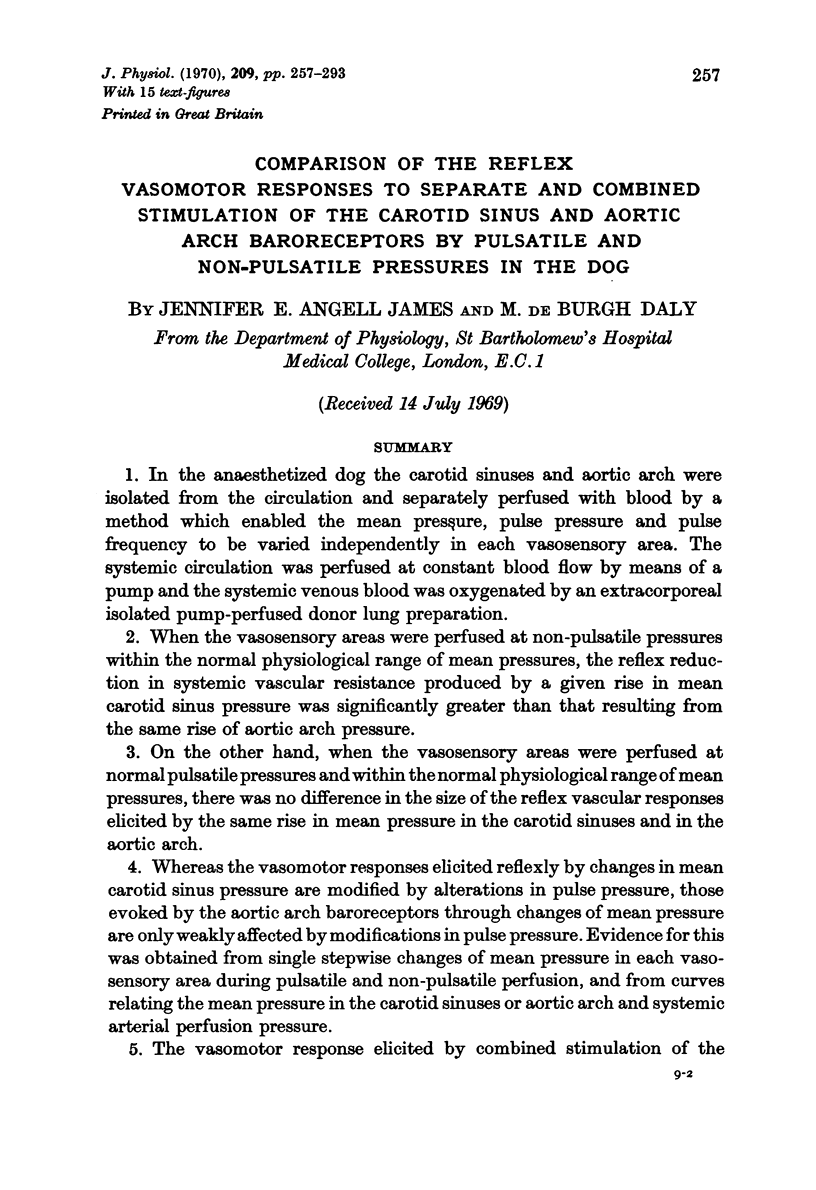
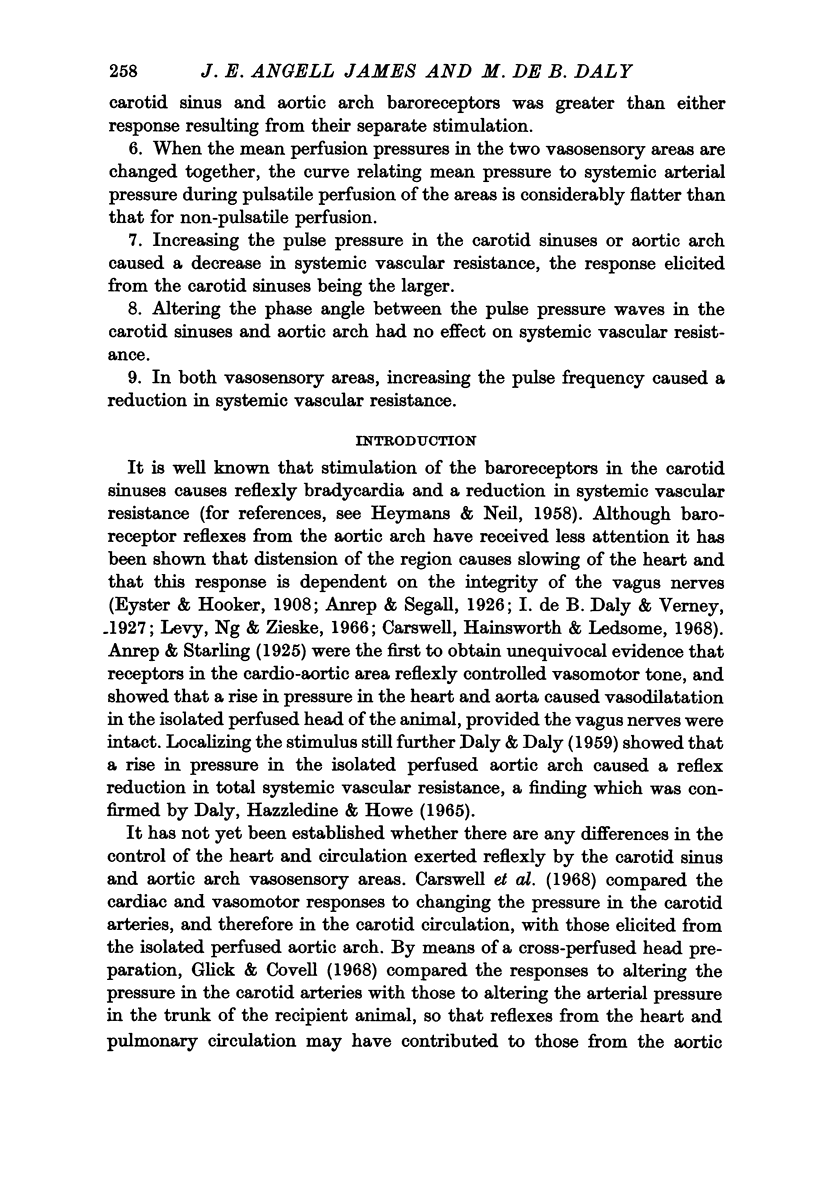
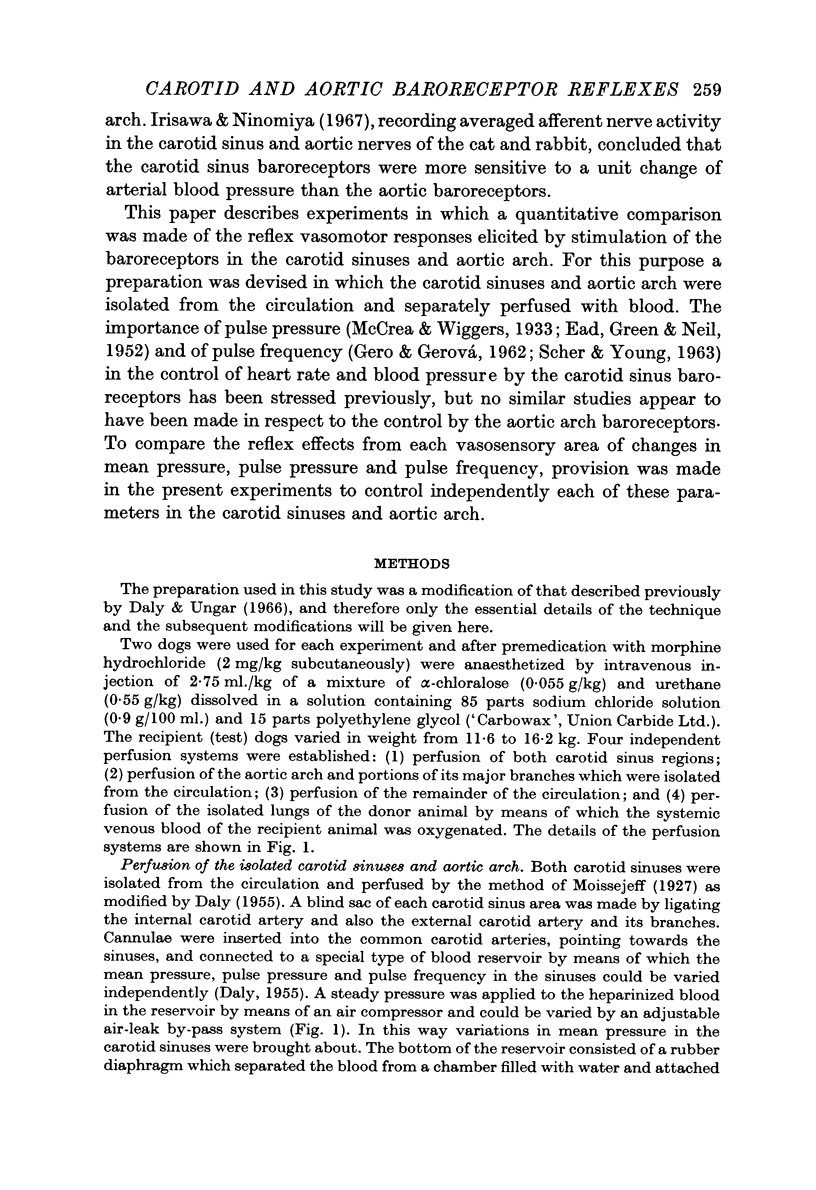

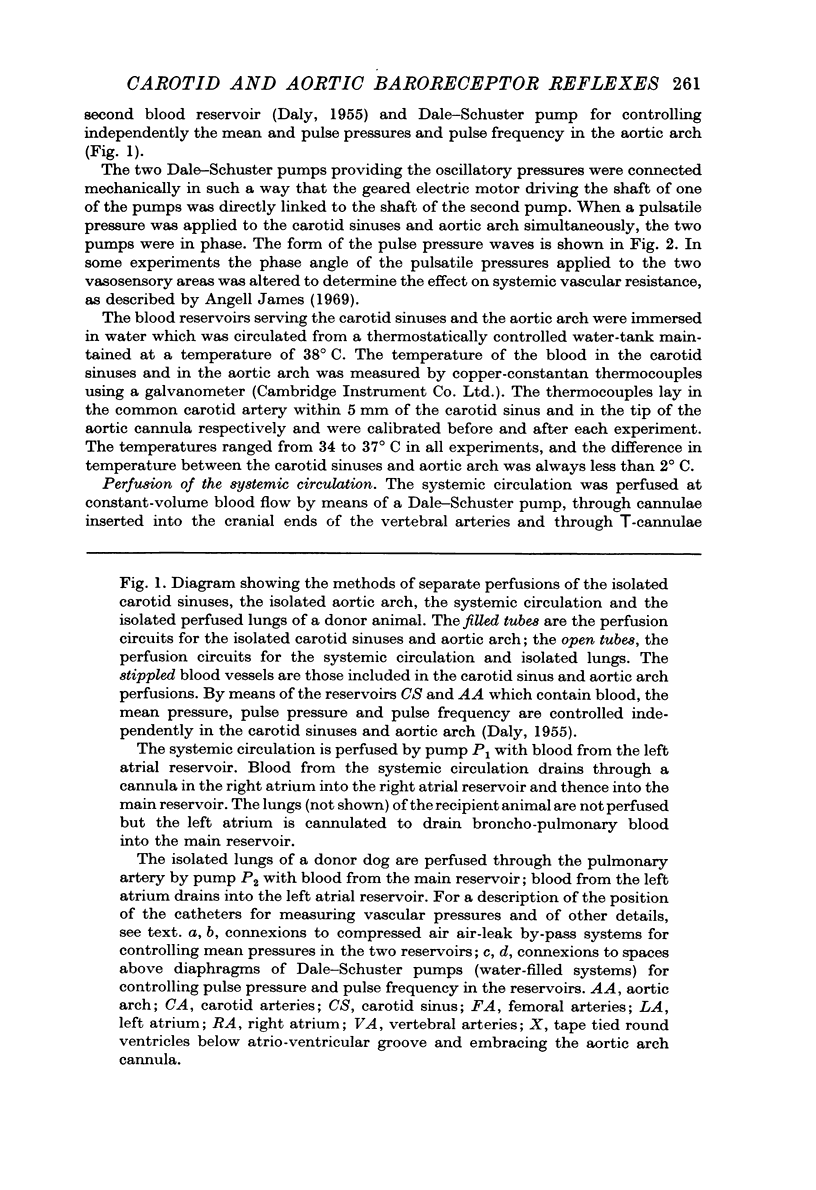
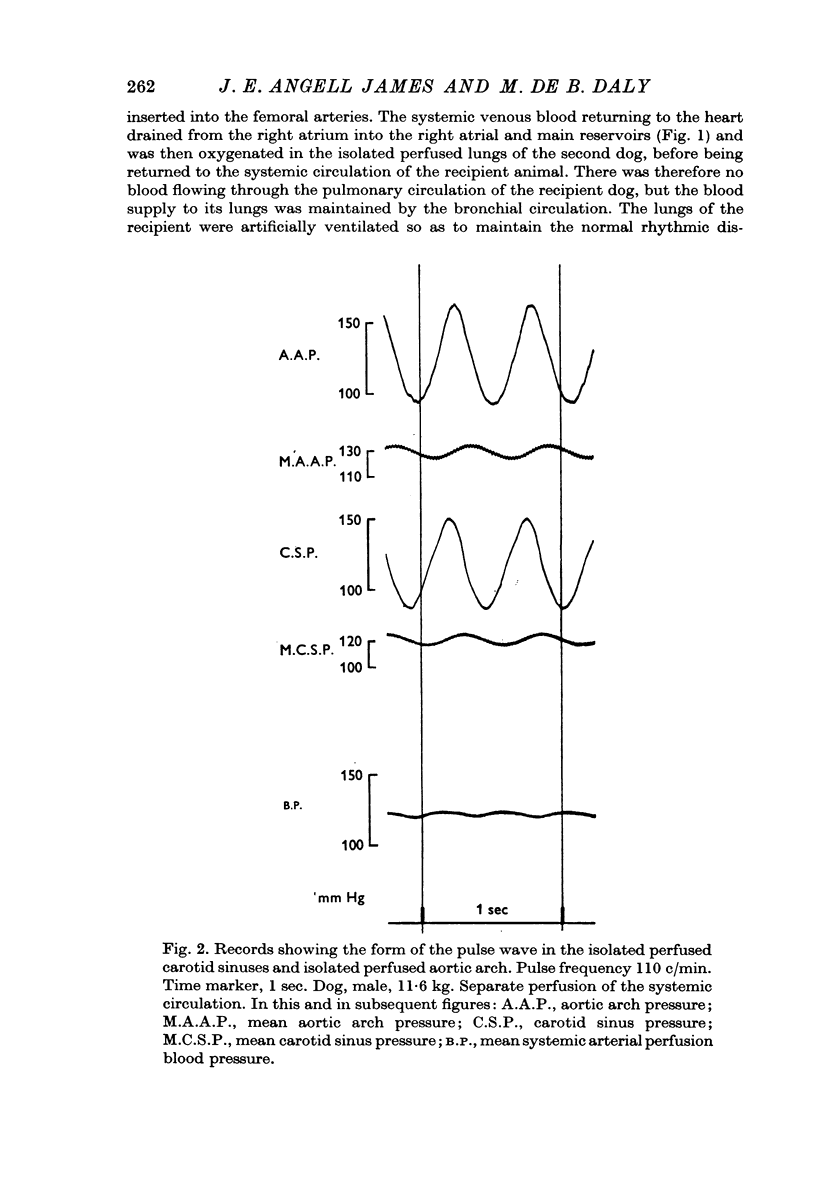

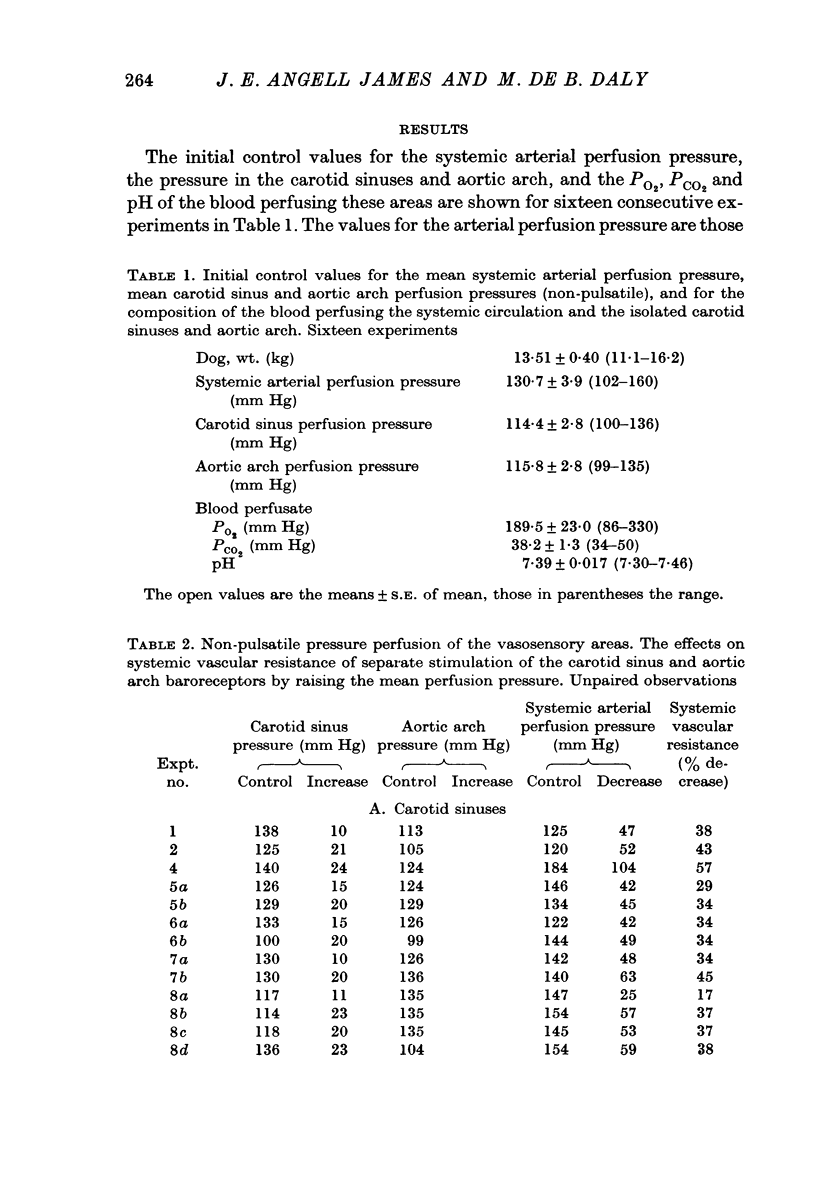

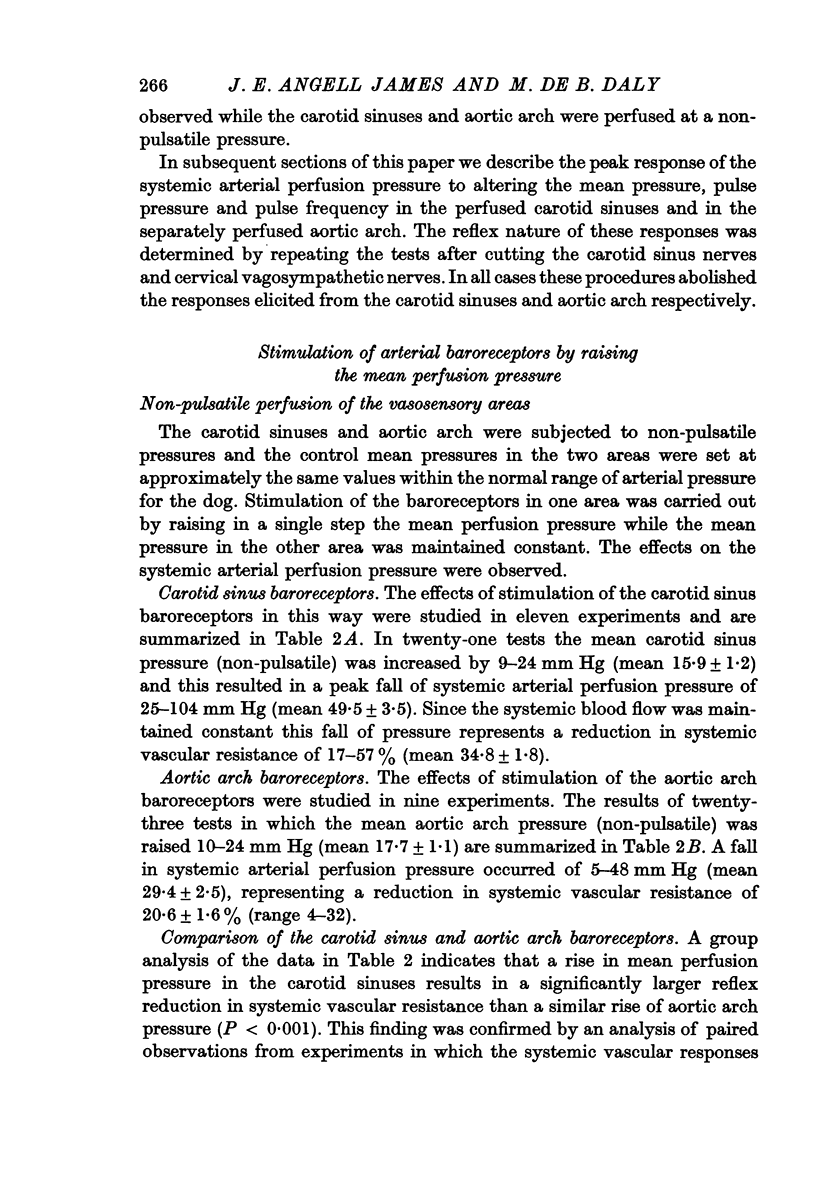
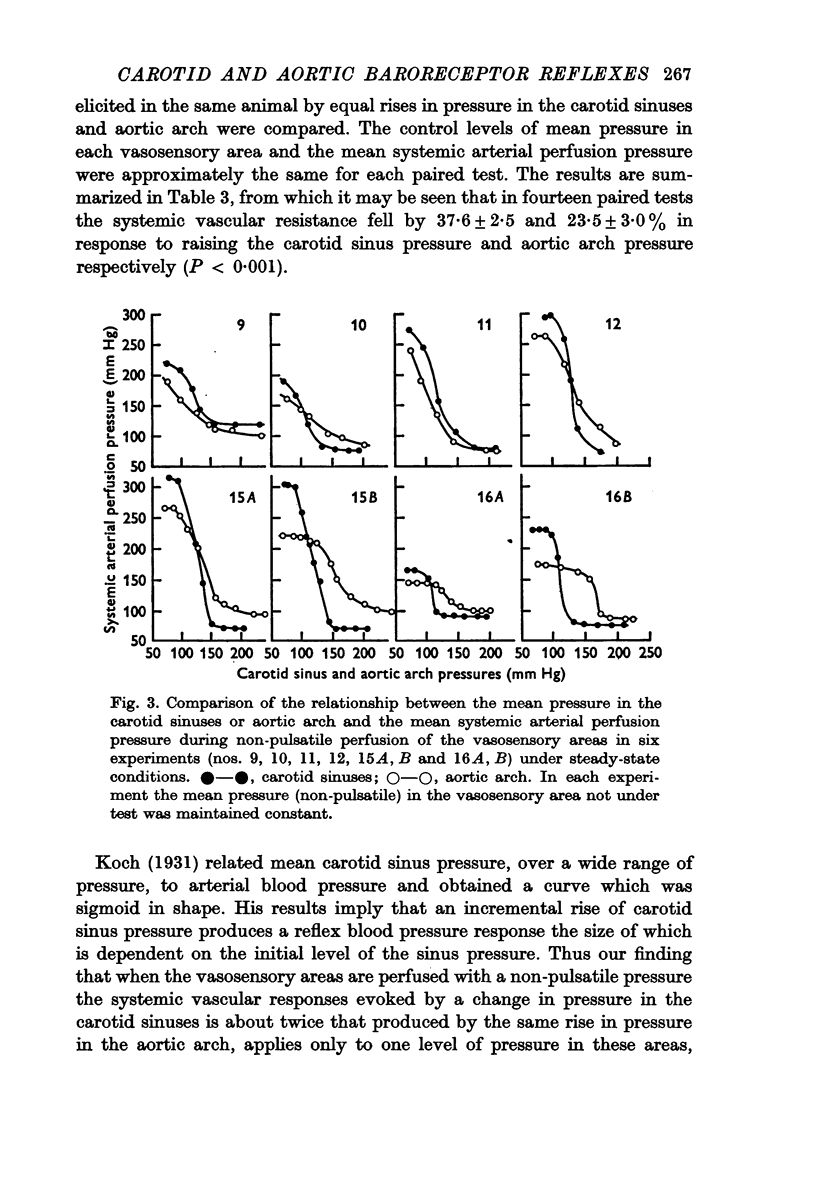
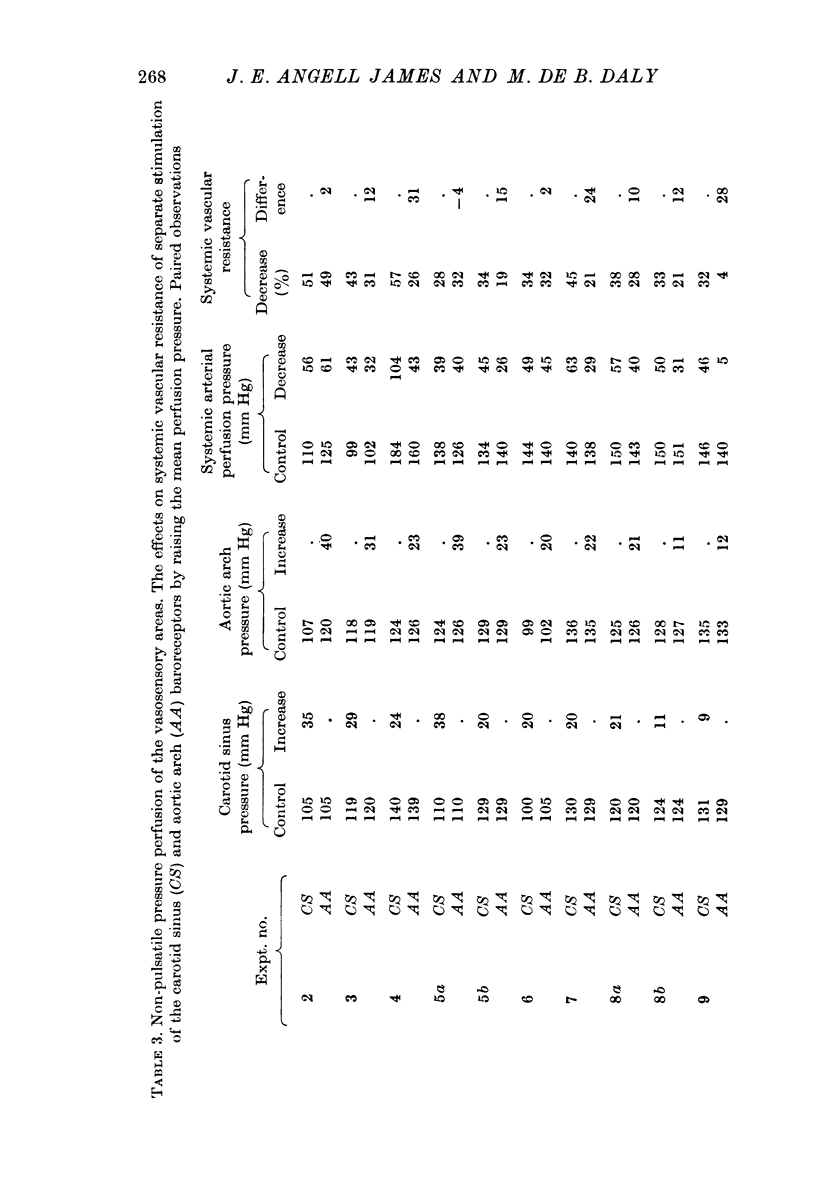
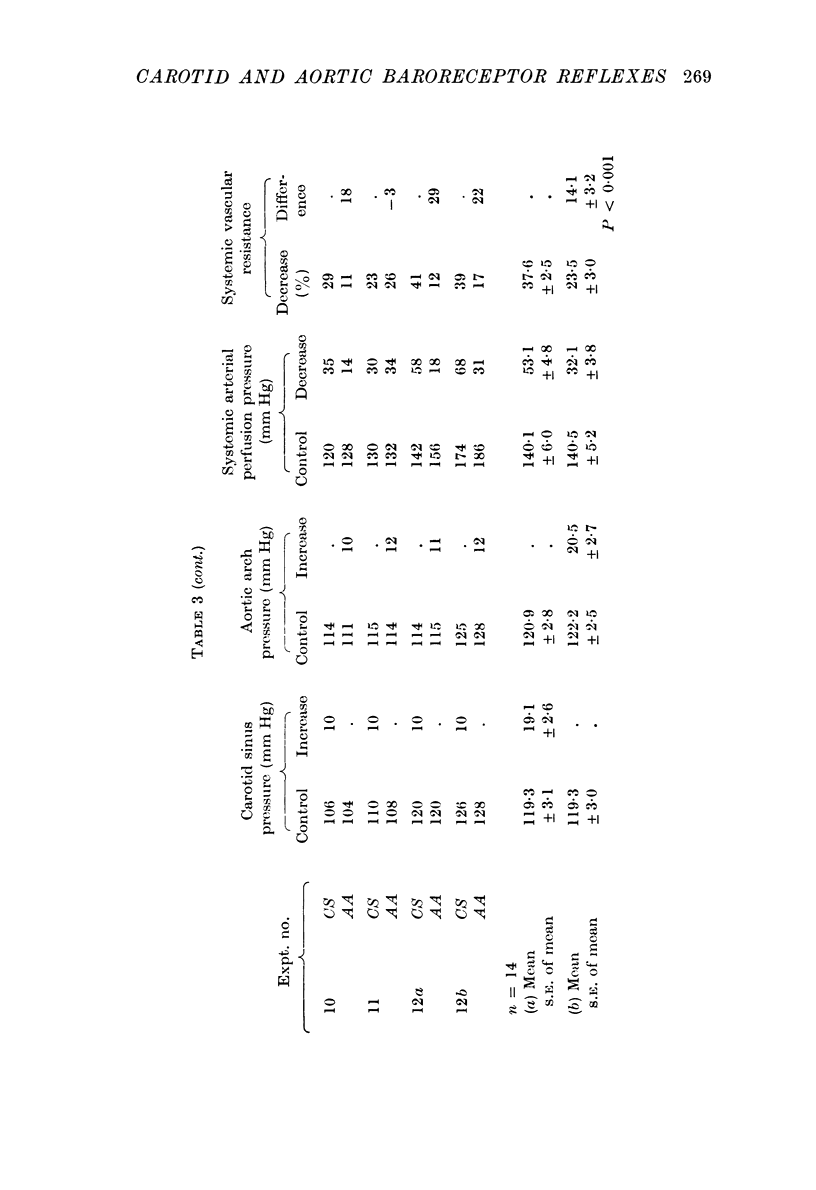

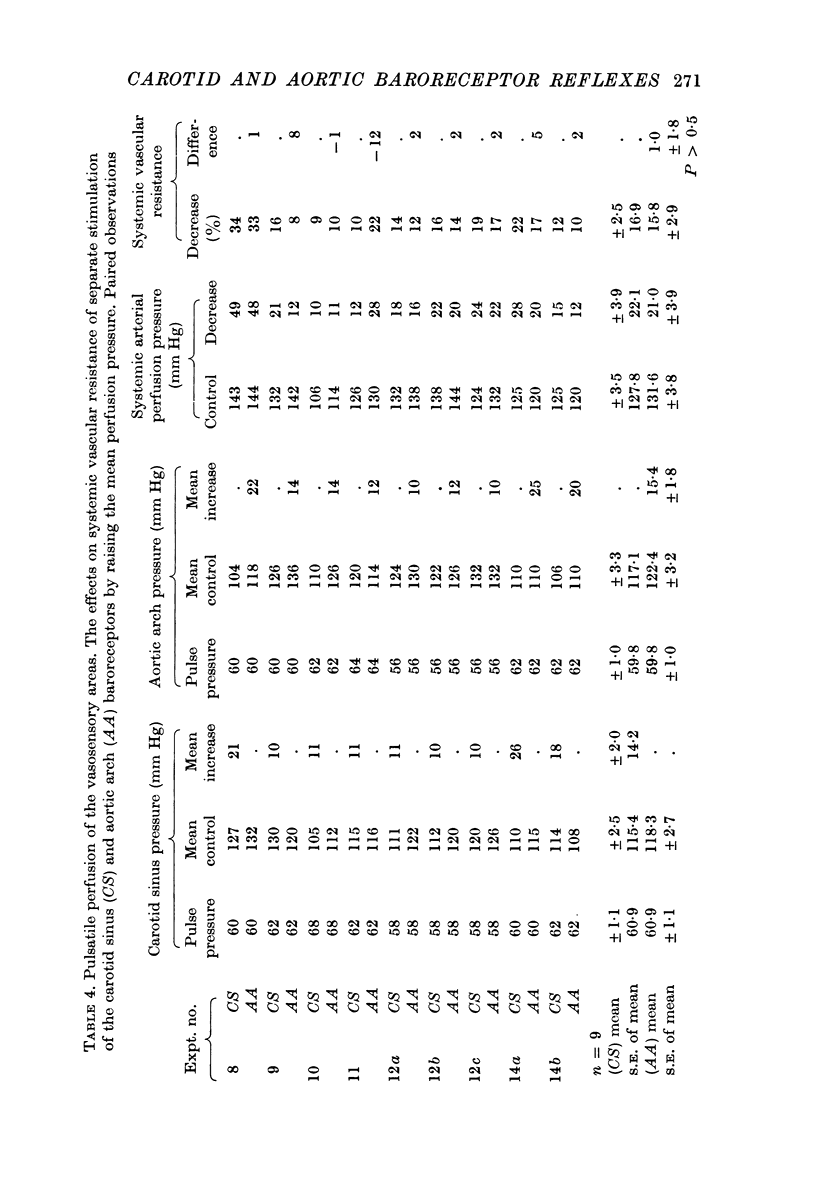
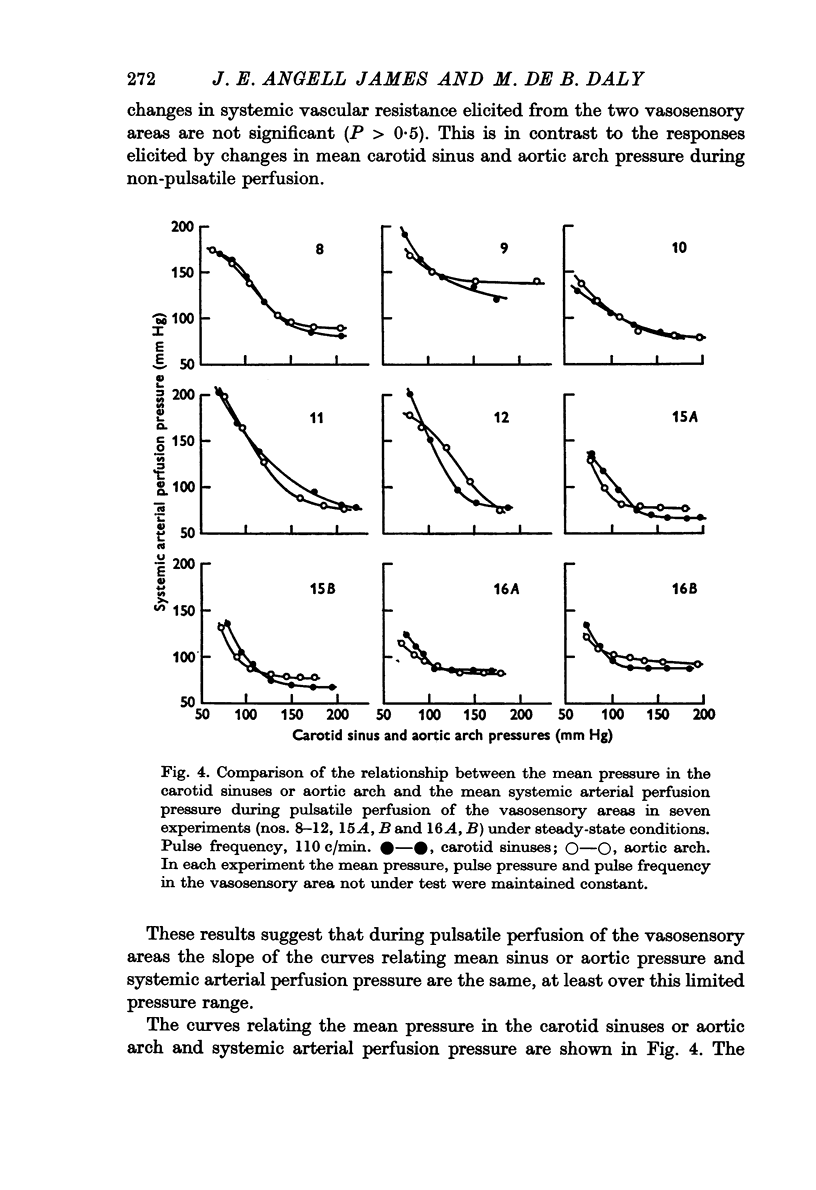
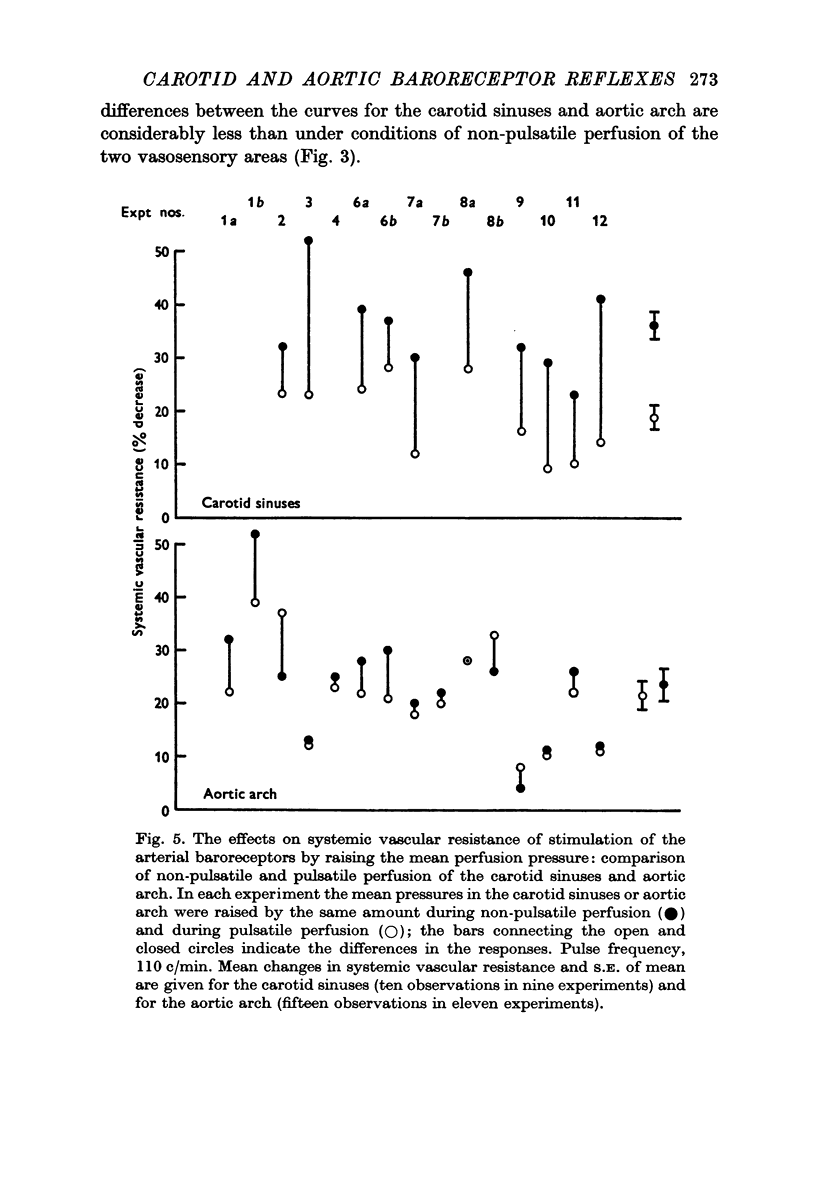
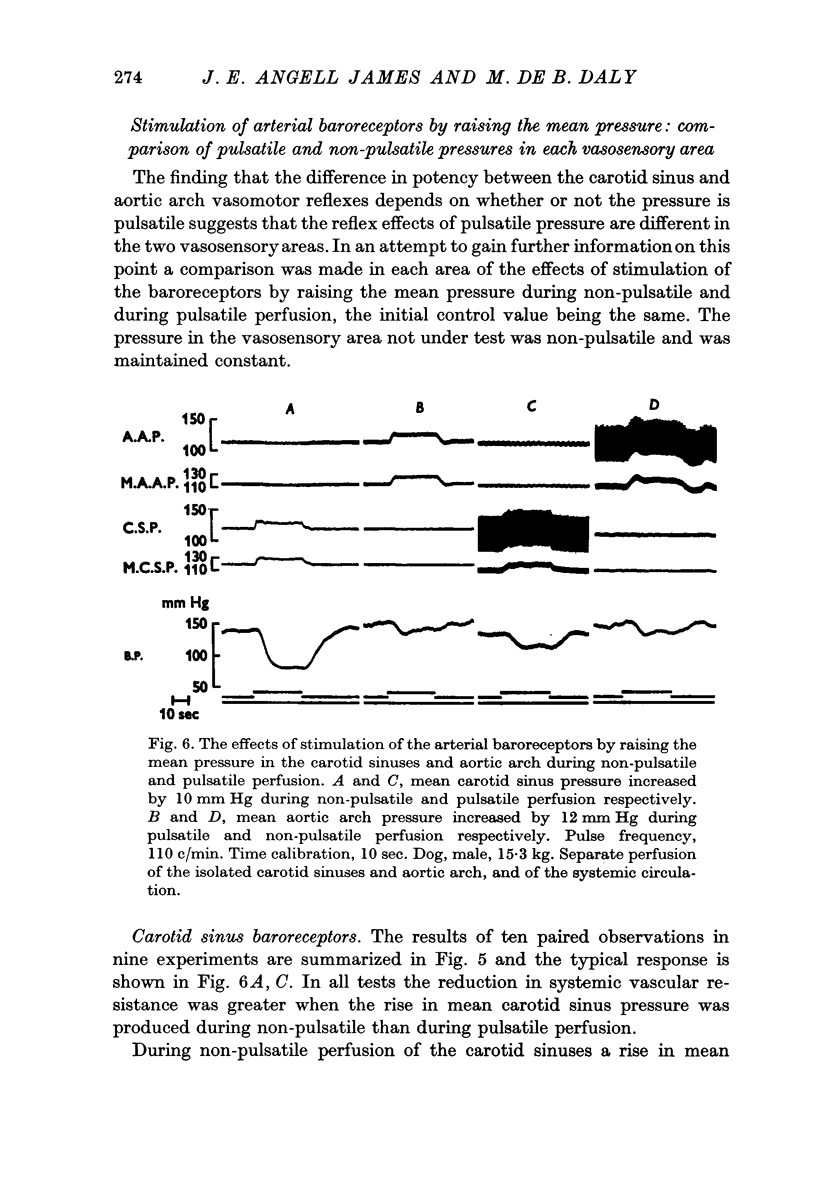
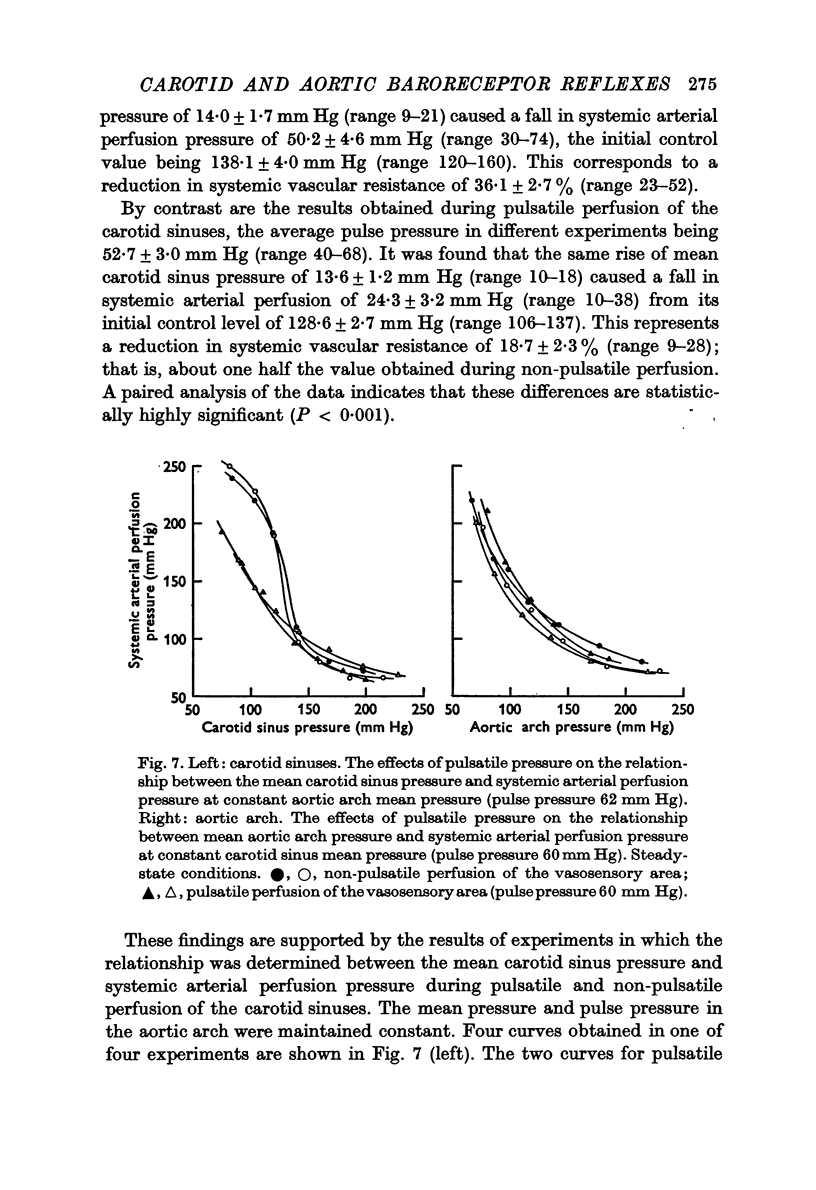
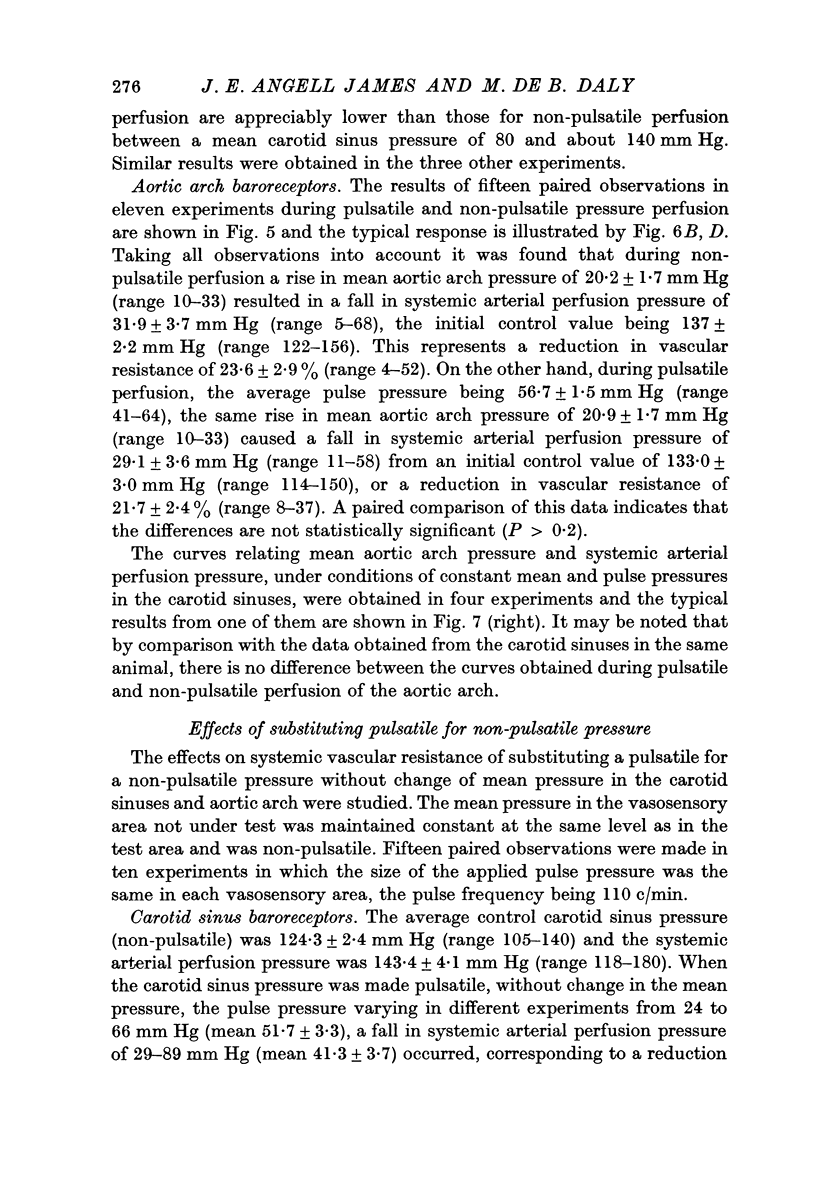
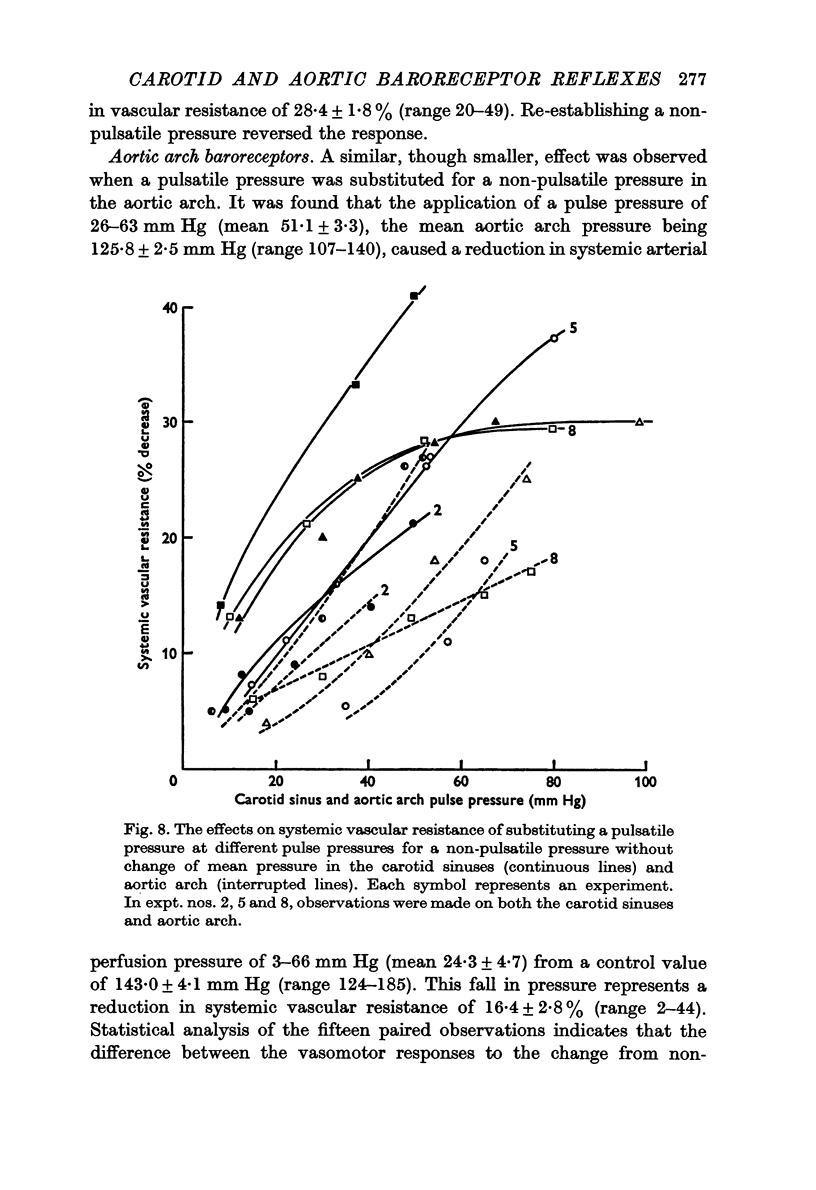
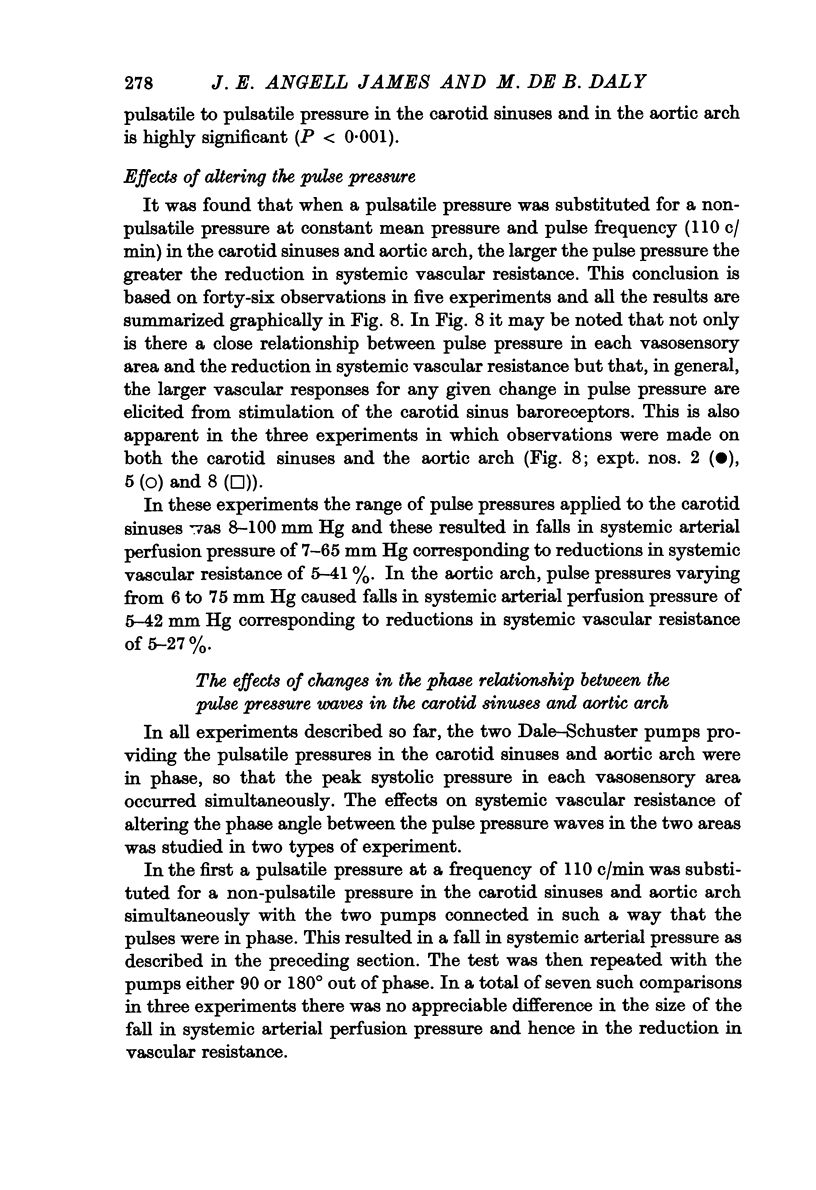
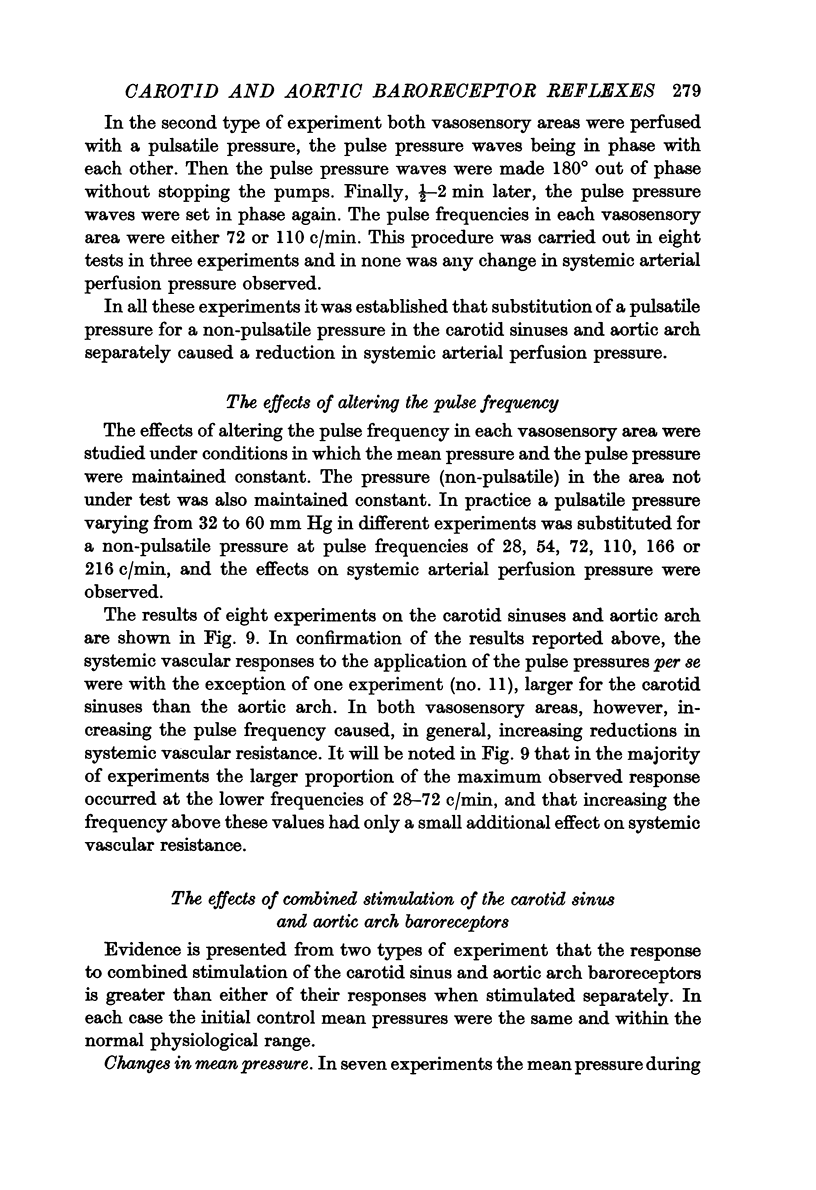
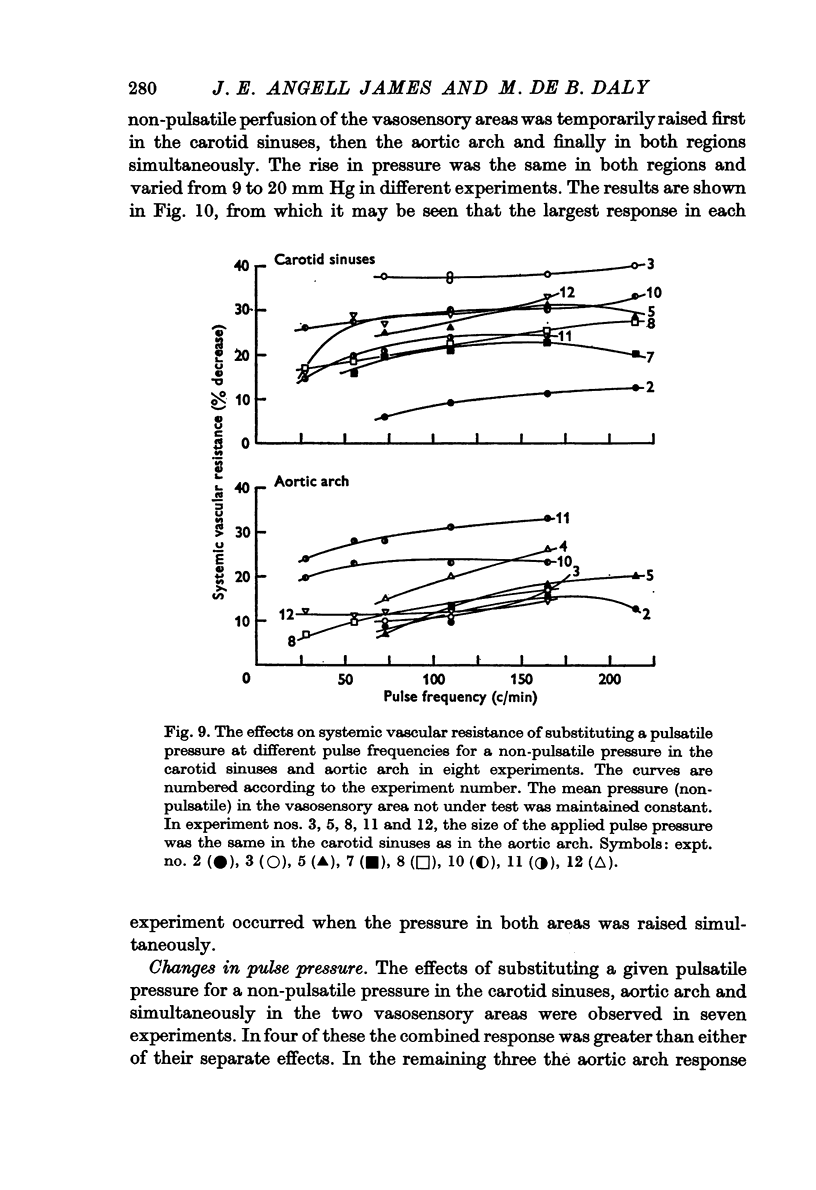

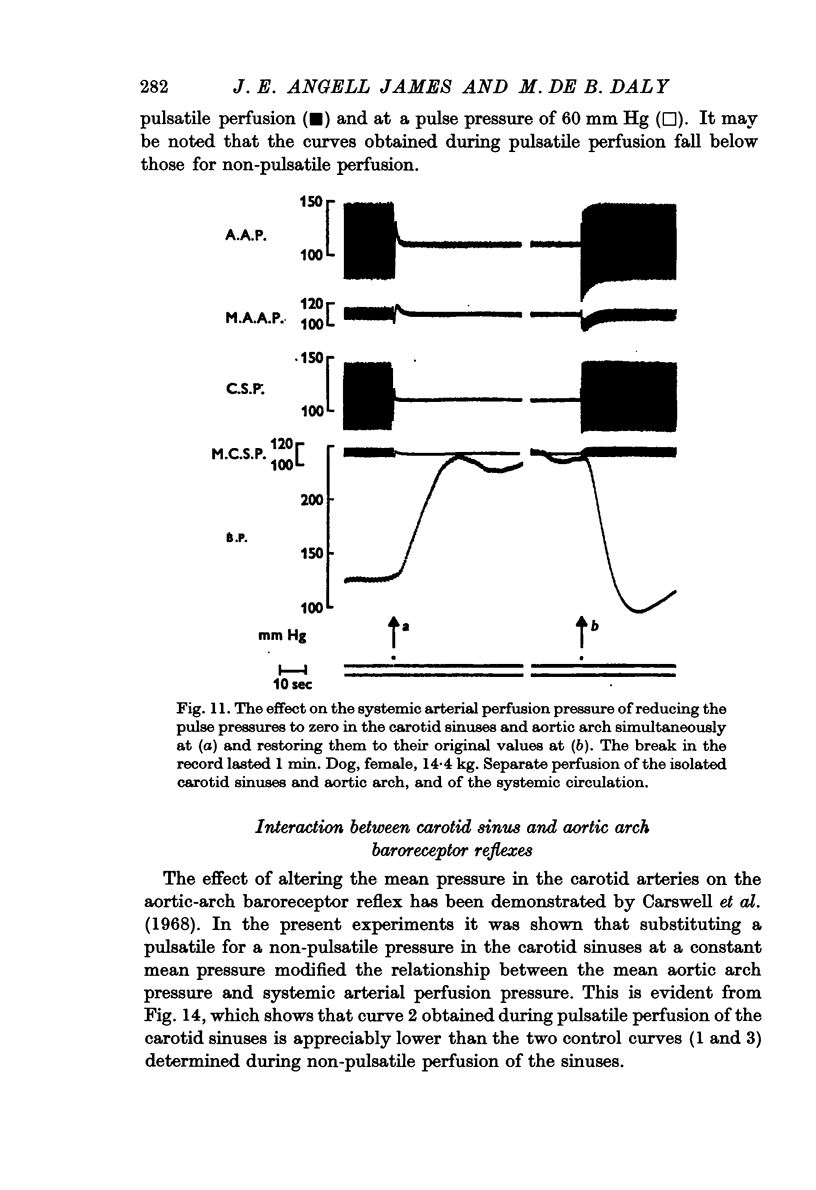
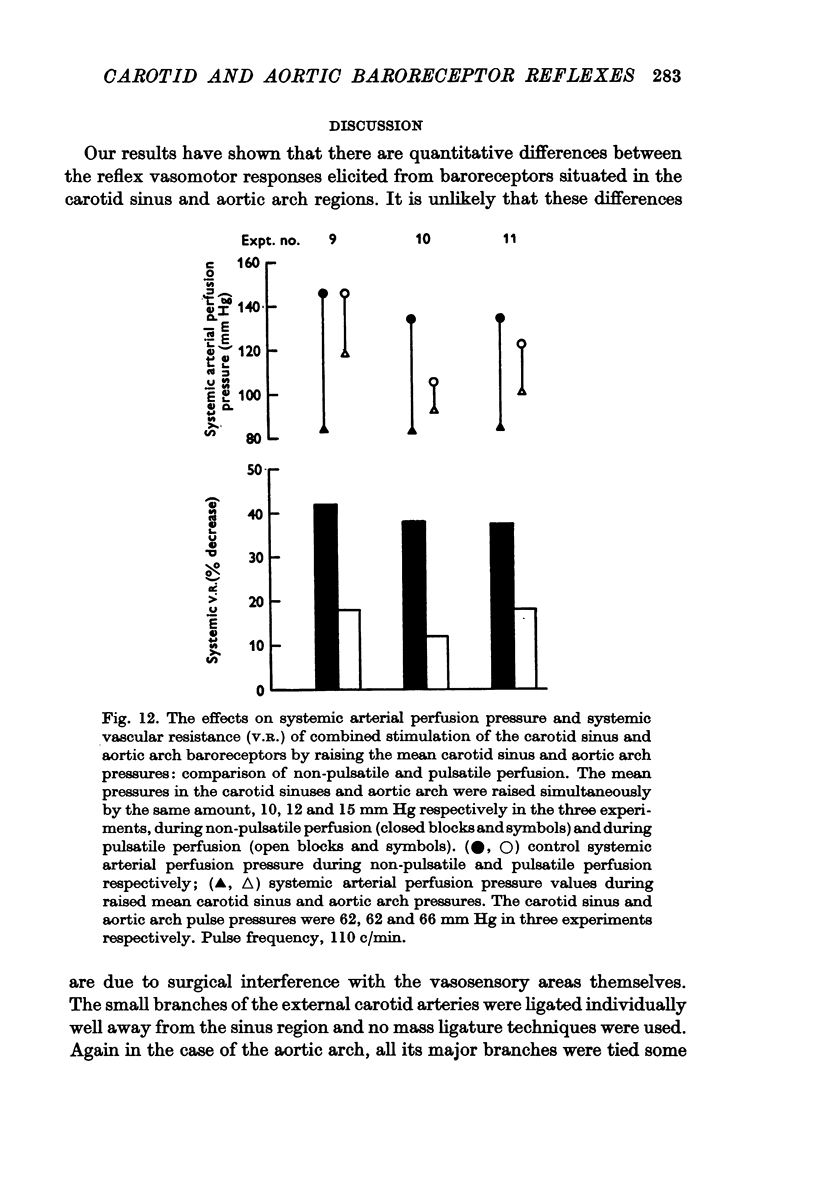
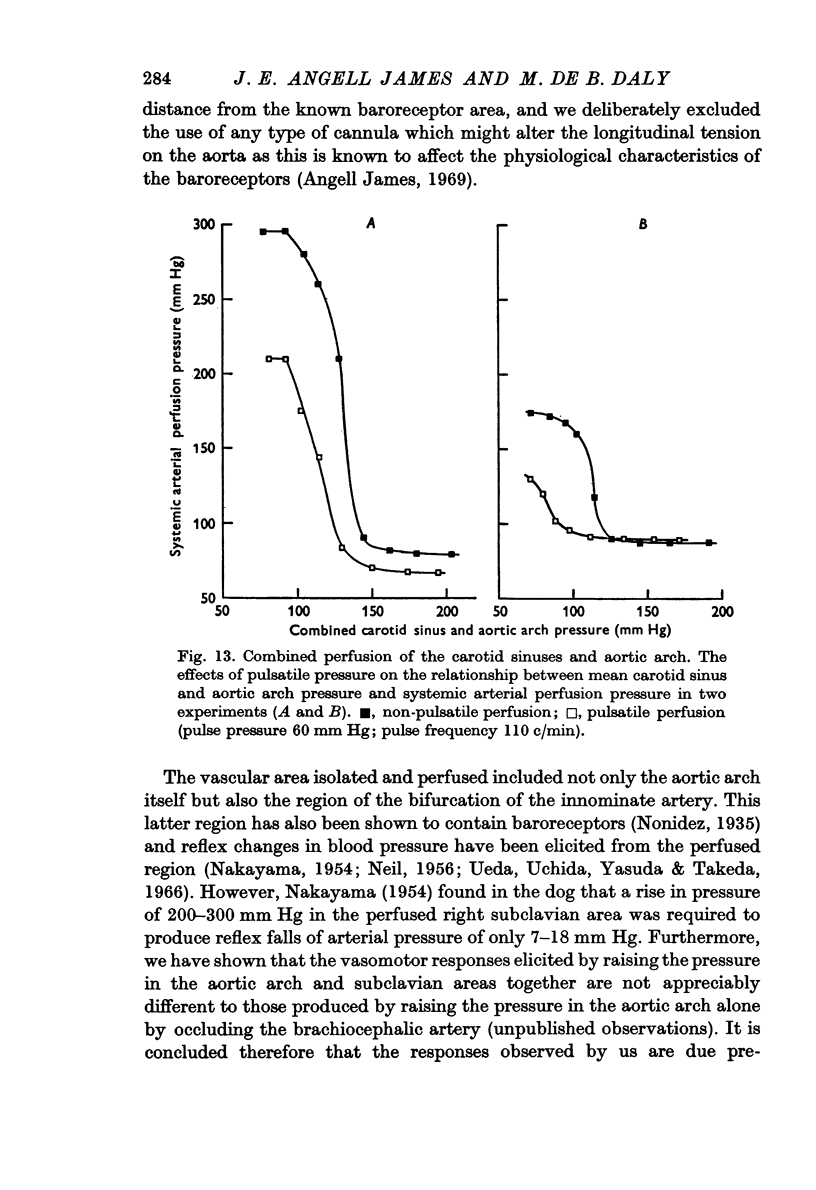
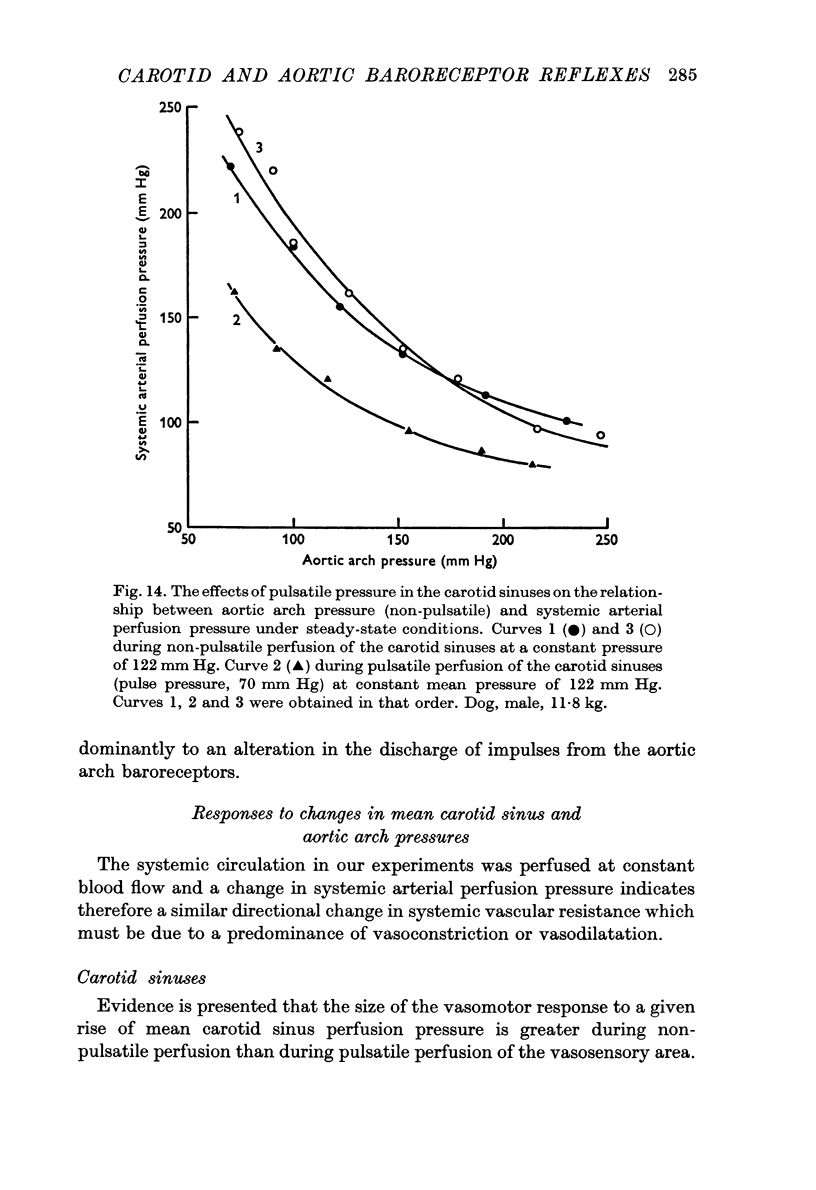
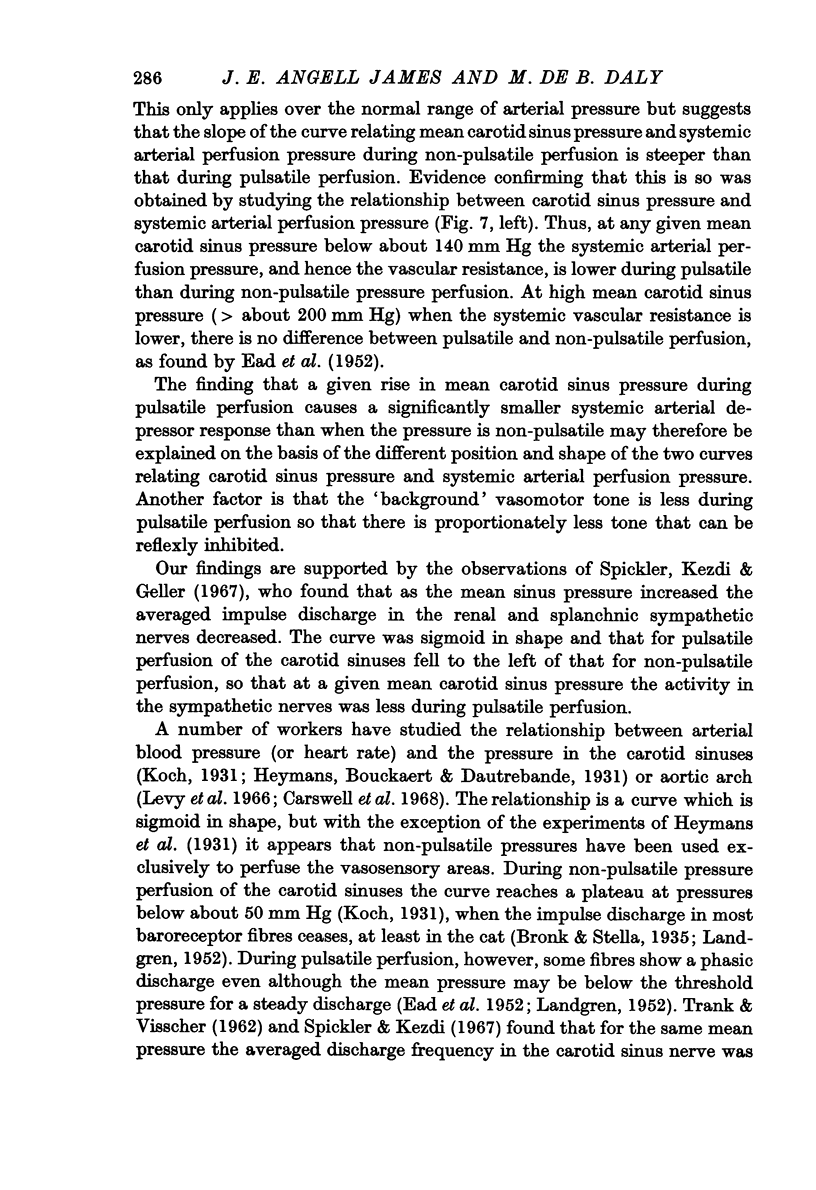
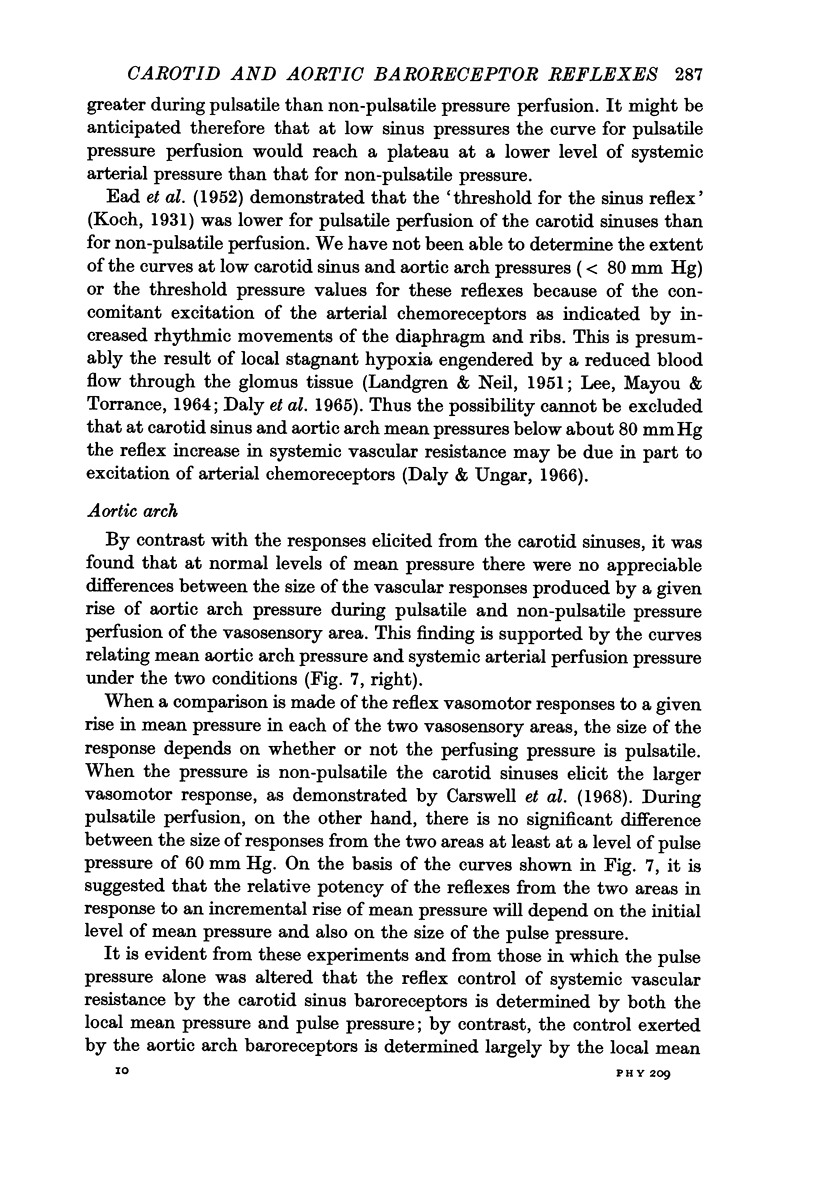

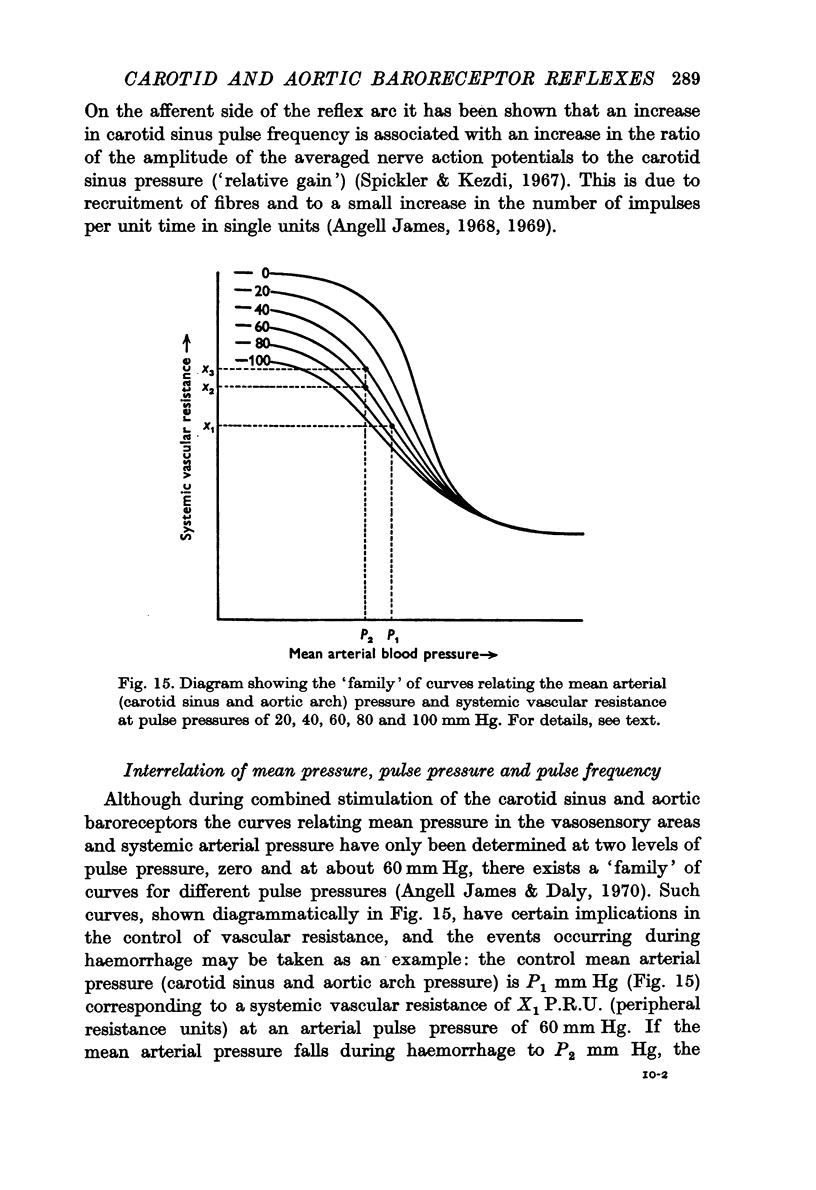
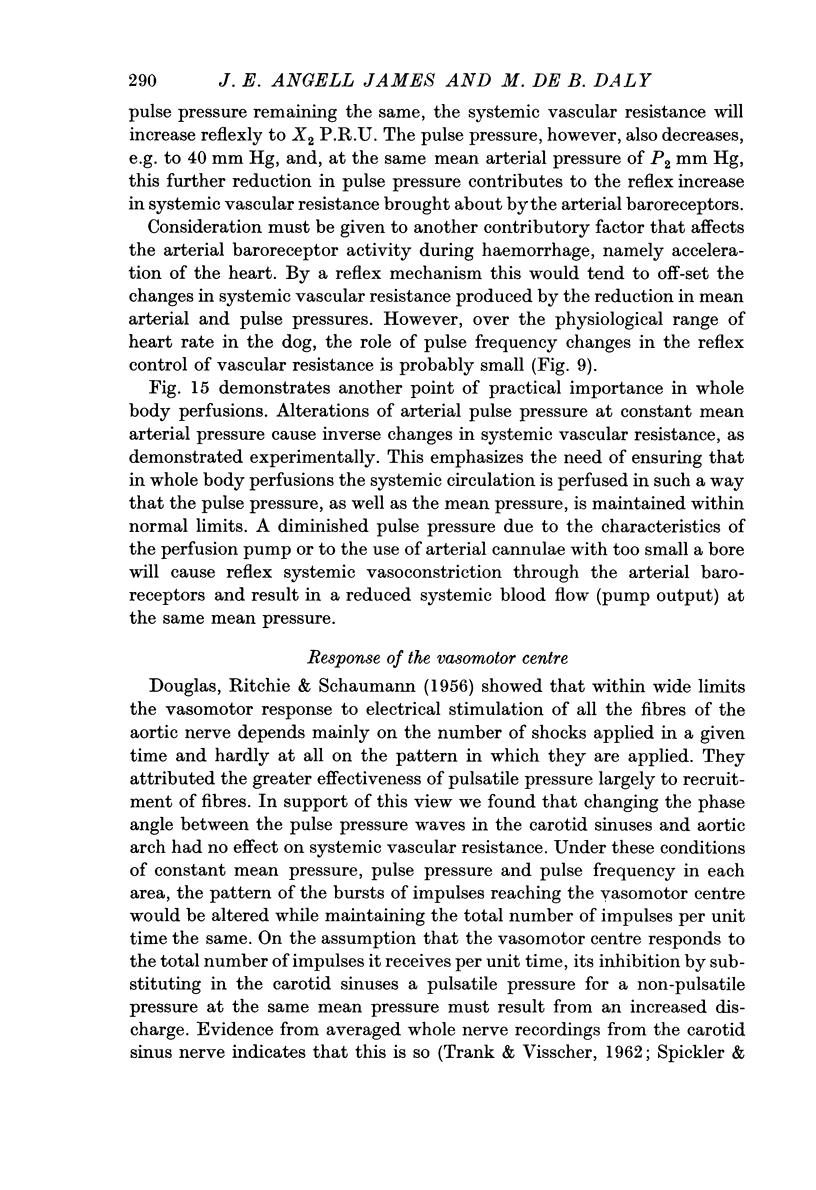
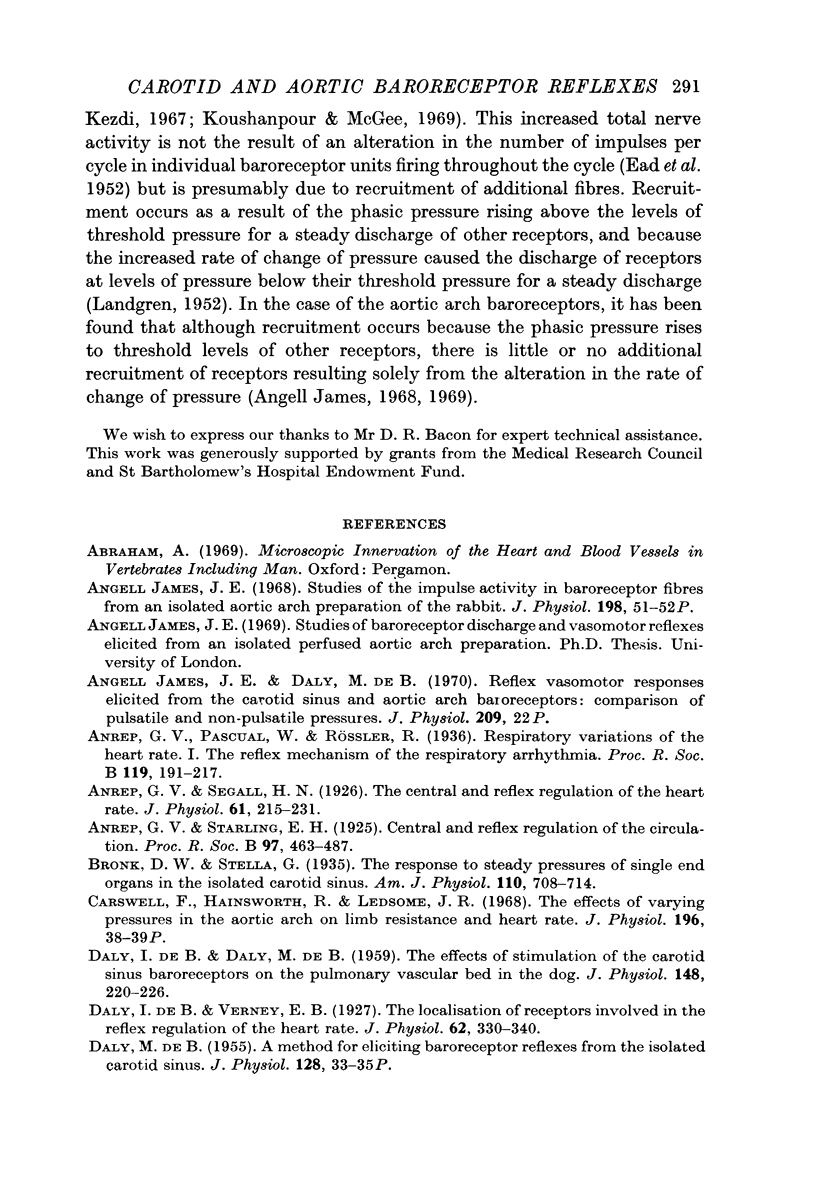
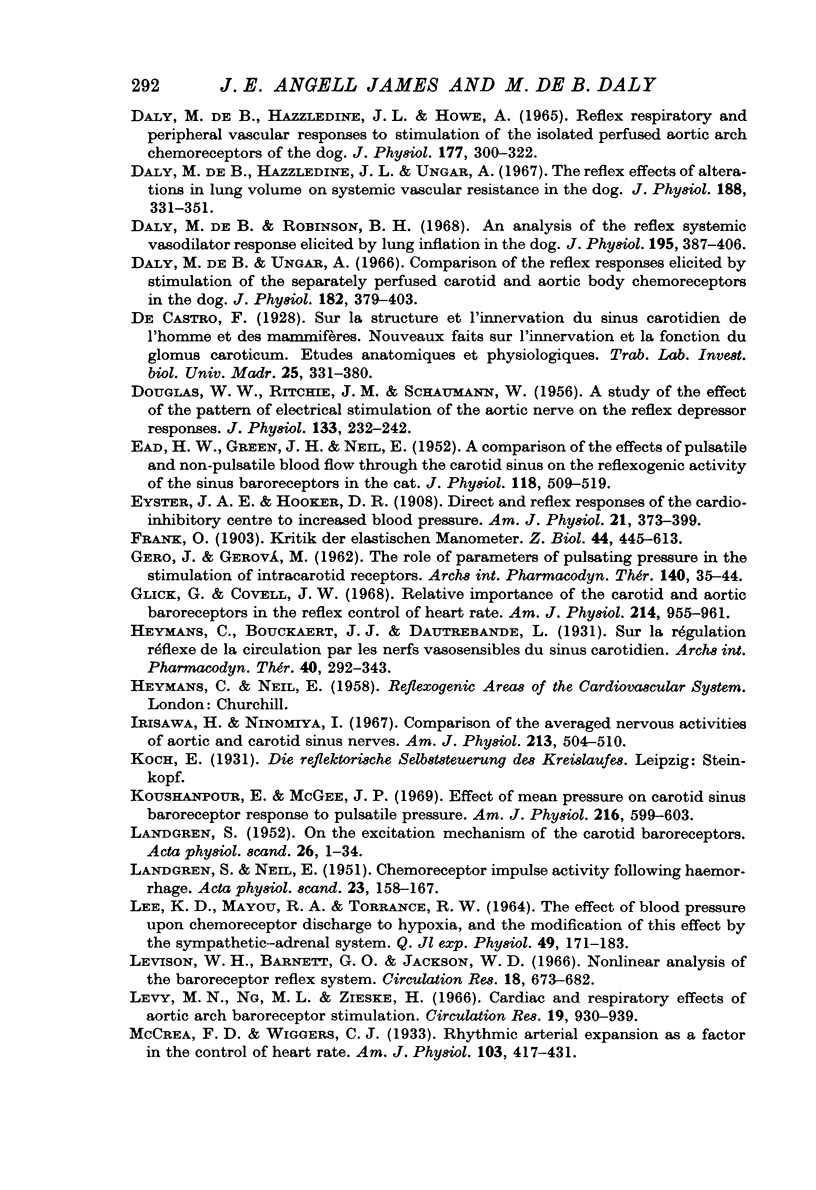

Selected References
These references are in PubMed. This may not be the complete list of references from this article.
- Anrep G. V., Segall H. N. The central and reflex regulation of the heart rate. J Physiol. 1926 Apr 23;61(2):215–231. doi: 10.1113/jphysiol.1926.sp002284. [DOI] [PMC free article] [PubMed] [Google Scholar]
- DALY I. D., DALY M. D. The effects of stimulation of the carotid sinus baroreceptors on the pulmonary vascular bed in the dog. J Physiol. 1959 Oct;148:220–226. doi: 10.1113/jphysiol.1959.sp006283. [DOI] [PMC free article] [PubMed] [Google Scholar]
- DALYMDE B., HAZZLEDINE J. L., HOWE A. REFLEX RESPIRATORY AND PERIPHERAL VASCULAR RESPONSES TO STIMULATION OF THE ISOLATED PERFUSED AORTIC ARCH CHEMORECEPTORS OF THE DOG. J Physiol. 1965 Mar;177:300–322. doi: 10.1113/jphysiol.1965.sp007593. [DOI] [PMC free article] [PubMed] [Google Scholar]
- DE BURGH DALY M. A method for eliciting baroreceptor reflexes from the isolated carotid sinus. J Physiol. 1955 May 27;128(2):33–5P. [PubMed] [Google Scholar]
- DOUGLAS W. W., RITCHIE J. M., SCHAUMANN W. A study of the effect of the pattern of electrical stimulation of the aortic nerve on the reflex depressor responses. J Physiol. 1956 Jul 27;133(1):232–242. doi: 10.1113/jphysiol.1956.sp005581. [DOI] [PMC free article] [PubMed] [Google Scholar]
- Daly I. de B., Verney E. B. The localisation of receptors involved in the reflex regulation of the heart rate. J Physiol. 1927 Mar 15;62(4):330–340. doi: 10.1113/jphysiol.1927.sp002363. [DOI] [PMC free article] [PubMed] [Google Scholar]
- Daly M. D., Robinson B. H. An analysis of the reflex systemic vasodilator response elicited by lung inflation in the dog. J Physiol. 1968 Mar;195(2):387–406. doi: 10.1113/jphysiol.1968.sp008464. [DOI] [PMC free article] [PubMed] [Google Scholar]
- Daly M., Ungar A. Comparison of the reflex responses elicited by stimulation of the separately perfused carotid and aortic body chemoreceptors in the dog. J Physiol. 1966 Jan;182(2):379–403. doi: 10.1113/jphysiol.1966.sp007828. [DOI] [PMC free article] [PubMed] [Google Scholar]
- De Burgh Daly M., Hazzledine J. L., Ungar A. The reflex effects of alterations in lung volume on systemic vascular resistance in the dog. J Physiol. 1967 Feb;188(3):331–351. doi: 10.1113/jphysiol.1967.sp008142. [DOI] [PMC free article] [PubMed] [Google Scholar]
- EAD H. W., GREEN J. H., NEIL E. A comparison of the effects of pulsatile and non-pulsatile blood flow through the carotid sinus on the reflexogenic activity of the sinus baroceptors in the cat. J Physiol. 1952 Dec;118(4):509–519. doi: 10.1113/jphysiol.1952.sp004812. [DOI] [PMC free article] [PubMed] [Google Scholar]
- GERO J., GEROVA M. The role of parameters of pulsating pressure in the stimulation of intracarotid receptors. Arch Int Pharmacodyn Ther. 1962 Nov 1;140:35–44. [PubMed] [Google Scholar]
- Glick G., Covell J. W. Relative importance of the carotid and aortic baroreceptors in the reflex control of heart rate. Am J Physiol. 1968 May;214(5):955–961. doi: 10.1152/ajplegacy.1968.214.5.955. [DOI] [PubMed] [Google Scholar]
- Irisawa H., Ninomiya I. Comparison of the averaged nervous activities of aortic and carotid sinus nerves. Am J Physiol. 1967 Aug;213(2):504–510. doi: 10.1152/ajplegacy.1967.213.2.504. [DOI] [PubMed] [Google Scholar]
- Koushanpour E., McGee J. P. Effect of mean pressure on carotid sinus baroceptor response to pulsatile pressure. Am J Physiol. 1969 Mar;216(3):599–603. doi: 10.1152/ajplegacy.1969.216.3.599. [DOI] [PubMed] [Google Scholar]
- LANDGREN S., NEIL E. Chemoreceptor impulse activity following haemorrhage. Acta Physiol Scand. 1951 Aug 25;23(2-3):158–167. doi: 10.1111/j.1748-1716.1951.tb00805.x. [DOI] [PubMed] [Google Scholar]
- LANDGREN S. On the excitation mechanism of the carotid baroceptors. Acta Physiol Scand. 1952 Jul 17;26(1):1–34. doi: 10.1111/j.1748-1716.1952.tb00889.x. [DOI] [PubMed] [Google Scholar]
- LEE K. D., MAYOU R. A., TORRANCE R. W. THE EFFECT OF BLOOD PRESSURE UPON CHEMORECEPTOR DISCHARGE TO HYPOXIA, AND THE MODIFICATION OF THIS EFFECT BY THE SYMPATHETIC-ADRENAL SYSTEM. Q J Exp Physiol Cogn Med Sci. 1964 Apr;49:171–183. doi: 10.1113/expphysiol.1964.sp001717. [DOI] [PubMed] [Google Scholar]
- Levison W. H., Barnett G. O., Jackson W. D. Nonlinear analysis of the baroreceptor reflex system. Circ Res. 1966 Jun;18(6):673–682. doi: 10.1161/01.res.18.6.673. [DOI] [PubMed] [Google Scholar]
- Levy M. N., Ng M. L., Zieske H. Cardiac and respiratory effects of aortic arch baroreceptor stimulation. Circ Res. 1966 Nov;19(5):930–939. doi: 10.1161/01.res.19.5.930. [DOI] [PubMed] [Google Scholar]
- NEIL E. Reflex responses elicited in the cat by perfusion of the root of the right subclavian artery. Arch Int Pharmacodyn Ther. 1956 Mar 1;105(3-4):468–476. [PubMed] [Google Scholar]
- PEASE D. C., PAULE W. J. Electron microscopy of elastic arteries; the thoracic aorta of the rat. J Ultrastruct Res. 1960 Jun;3:469–483. doi: 10.1016/s0022-5320(60)90023-x. [DOI] [PubMed] [Google Scholar]
- RUSHMER R. F. Pressure-circumference relations in the aorta. Am J Physiol. 1955 Dec;183(3):545–549. doi: 10.1152/ajplegacy.1955.183.3.545. [DOI] [PubMed] [Google Scholar]
- Rees P. M. Electron microscopical observations on the architecture of the carotid arterial walls, with special reference to the sinus portion. J Anat. 1968 Jun;103(Pt 1):35–47. [PMC free article] [PubMed] [Google Scholar]
- Rees P. M. Observations on the fine structure and distribution of presumptive baroreceptor nerves at the carotid sinus. J Comp Neurol. 1967 Dec;131(4):517–548. doi: 10.1002/cne.901310409. [DOI] [PubMed] [Google Scholar]
- SCHER A. M., YOUNG A. C. Servoanalysis of carotid sinus reflex effects on peripheral resistance. Circ Res. 1963 Feb;12:152–162. doi: 10.1161/01.res.12.2.152. [DOI] [PubMed] [Google Scholar]
- Sagawa K., Watanabe K. Summation of bilateral carotid sinus signals in the barostatic reflex. Am J Physiol. 1965 Dec;209(6):1278–1286. doi: 10.1152/ajplegacy.1965.209.6.1278. [DOI] [PubMed] [Google Scholar]
- Spickler J. W., Kezdi P. Dynamic response characteristics of carotid sinus baroreceptors. Am J Physiol. 1967 Feb;212(2):472–476. doi: 10.1152/ajplegacy.1967.212.2.472. [DOI] [PubMed] [Google Scholar]
- Stegemann J., Tibes U. Der Einfluss von Amplitude, Frequenz und Mittelwert sinusförmiger Reizdrucke an den Pressoreceptoren auf den arteriellen Mitteldruck des Hundes. Pflugers Arch. 1969;305(3):219–228. doi: 10.1007/BF00587276. [DOI] [PubMed] [Google Scholar]
- TRANK J. W., VISSCHER M. B. Carotid sinus baroceptor modifications associated with endotoxin shock. Am J Physiol. 1962 May;202:971–977. doi: 10.1152/ajplegacy.1962.202.5.971. [DOI] [PubMed] [Google Scholar]
- Ueda H., Uchida Y., Yasuda H., Takeda T. Reflex control of blood pressure by the right subclavian baroreceptor in experimental renal hypertension of rabbit. Jpn Heart J. 1966 Nov;7(6):543–555. doi: 10.1536/ihj.7.543. [DOI] [PubMed] [Google Scholar]


